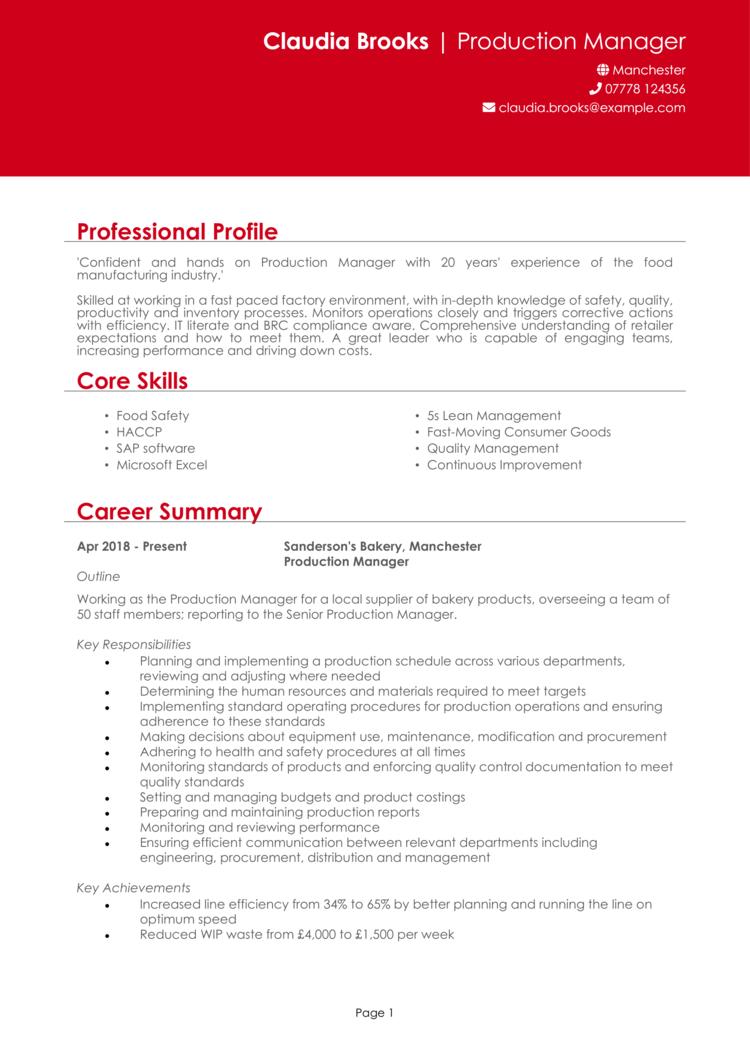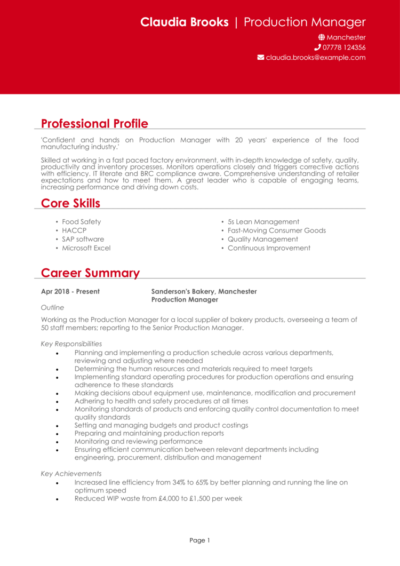From manufacturing to events, you’re the person behind the curtain keeping everything on schedule, under budget, and totally stress-free (for everyone else, that is). But even the most experienced production manager needs a finely tuned CV to land their next big role.
With this guide, and its accompanying Production Manager CV examples, you’ll be able to shape a CV that shows off those coveted leadership abilities and convince hiring managers of your ability to deliver results – on time and at scale.
Production Manager CV

Manufacturing Manager CV

How to write your Production Manager CV
Discover how to craft a winning Production Manager CV that lands interviews with this simple step-by-step guide.
Production managers operate at the heart of the process – where strategy meets output. Whether you’re managing a workshop floor or coordinating a broadcast schedule, your ability to maintain order under pressure is what sets you apart.
Writing a CV might not be on your Gantt chart, but consider this your top priority until you land the role. You’ll learn how to write one which reflects your leadership, organisational skills, and capacity to deliver consistently in fast-moving environments. It’s all about presenting your strengths in a way that employers can quickly understand and trust.
The best way to structure and format your Production Manager CV


Production management is all about precision and process – and your CV should reflect that. A well-organised structure allows employers to quickly see your relevant experience and understand how you’ve contributed to successful project delivery. A cluttered CV full of mistakes is like a production floor with no layout – someone’s going to trip over it.
Here’s the layout to follow:
- Name and contact details – Keep your name and personal details front and centre at the top. Whether or not to include a photo is your decision.
- Profile – Start with a snapshot of your skills, career highlights, and professional aspirations.
- Core skills – Focus on core skills, making it easy for employers to see your key strengths at a glance.
- Work experience – Walk through your professional experience, beginning with your latest position and moving backwards.
- Education & certifications – Include degrees, technical qualifications, or safety training.
- Additional info – This section is optional, but it’s a good place for hobbies and interests that complement your CV.
Keep your CV to a maximum length of two pages, use bullet points to break down dense information, and ensure each section is clearly defined with appropriate headings. Choose a professional, easy-to-read font that doesn’t distract from the content. A formatted CV which follows these tips not only looks better – it shows you know how to prioritise and present key information efficiently, and maintain high standards in every part of your work.
What is a Production Manager CV profile?


Think of this section as your executive summary – except you’re the project, and the delivery’s on you. Your CV profile is the first chance to show recruiters you’re the kind of person who can manage a team and solve problems without disrupting the workflow.
Keep it short and focused, and make it specific to your area of production. And skip the clichés – no one’s hiring a ‘hard-working team player’ unless they know what you’ve built, led, or saved.
Production Manager CV profile examples
Profile 1
Experienced Production Manager with over seven years of experience leading manufacturing operations in the FMCG and packaging sectors. Skilled in production planning, team supervision, and lean manufacturing principles. Proficient in ERP systems such as SAP and Oracle. Known for driving operational efficiency, ensuring quality standards, and managing shift-based teams to meet strict delivery deadlines.
Profile 2
Results-driven Production Manager with six years of experience overseeing daily operations in high-volume assembly and fabrication environments. Adept at workforce coordination, capacity planning, and implementing continuous improvement initiatives. Strong focus on safety compliance, cost reduction, and cross-departmental collaboration. Proven record of meeting KPIs in fast-paced industrial settings.
Profile 3
Detail-oriented Production Manager with eight years of experience in electronics and precision engineering industries. Experienced in managing end-to-end production workflows, maintaining ISO quality standards, and leading teams through process optimisation projects. Proficient in inventory control, root cause analysis, and technical documentation. Committed to on-time delivery and production excellence.
Details to put in your Production Manager CV profile
Here’s what to include in your profile:
- Where you’ve worked – Highlight the types of companies or projects you’ve managed.
- Your top qualifications – Mention degrees, technical certifications, or leadership training.
- Essential skills – Focus on your ability to manage teams, schedules, and budgets.
- Production environment – Mention if you’ve worked with live broadcasts, high-volume manufacturing, agile software teams, etc.
- Project or delivery scope – Share scale – how many people you led, budgets handled, or timelines delivered.
How to highlight your core skills


The core skills section gives recruiters an immediate snapshot of what you bring to the role. It should highlight the knowledge and competencies that enable you to run production processes smoothly. This isn’t the place for vague buzzwords – focus on the practical, tangible skills that reflect how you operate day to day.
Think about technical tools you use, methodologies you rely on, and your approach to problem-solving or communication. Tailor your bullet points to match the type of production environment you’re targeting and ensure each item adds real value.
Essential skills for a Production Manager CV
- Production Planning and Scheduling – Developing efficient production timelines to meet output targets and customer deadlines.
- Team Leadership and Supervision – Managing production staff, providing training, and ensuring optimal team performance.
- Workflow Optimisation – Streamlining manufacturing processes to improve efficiency, reduce downtime, and increase output.
- Quality Control and Assurance – Monitoring product quality, implementing inspections, and ensuring compliance with industry standards.
- Inventory and Resource Management – Overseeing raw material availability, equipment usage, and stock control to maintain continuous production.
- Health and Safety Compliance – Enforcing safety protocols, conducting risk assessments, and ensuring regulatory compliance on the production floor.
- Cost Control and Budgeting – Managing production budgets, identifying cost-saving opportunities, and reducing waste.
- Cross-Department Collaboration – Coordinating with procurement, logistics, engineering, and quality assurance teams to align operations.
- Performance Monitoring and Reporting – Tracking KPIs such as productivity, defect rates, and downtime to inform strategic decisions.
- Continuous Improvement Initiatives – Leading Lean, Six Sigma, or other improvement programs to drive operational excellence.
How to showcase your work experience in your CV


Employers want to see proof that you can lead operations and deliver results. This section should show where you’ve worked, what you were responsible for, and – most importantly – what you achieved.
List your work experience from most recent to oldest. For each, include your job title, employer, and dates. Use bullet points to explain what you did and the outcomes you helped deliver – such as efficiency improvements or successful launches.
How to format previous jobs in your CV correctly

- Outline – Introduce the company or production setting you worked in, and give a snapshot of your role and team size.
- Responsibilities – Use strong action words like “led,” “streamlined,” “oversaw,” or “implemented,” and describe your key duties – e.g. scheduling, budgeting, supplier coordination, or team supervision.
- Achievements – Quantify the results of your work whenever possible. For example: “Reduced production delays by 30% through new scheduling system,” or “Delivered 25+ live productions annually with zero safety incidents.”
Example work history for Production Managers
Production Manager | Apex Components Ltd
Outline
Led production operations for a precision engineering firm, overseeing CNC machining, assembly, and packaging lines to meet client-specific requirements.
Responsibilities
- Managed a team of 35 operatives across day and night shifts.
- Scheduled production runs and monitored throughput to meet delivery deadlines.
- Implemented quality control procedures in line with ISO 9001 standards.
- Identified and resolved bottlenecks through process improvement initiatives.
- Maintained production records and reported KPIs to senior management.
Achievements
- Increased productivity by 18% through equipment reorganisation and line balancing.
- Reduced scrap rates by 25% by introducing operator training and improved inspection routines.
- Helped secure a new aerospace client by meeting strict quality and delivery criteria.
Production Manager | Nordex Foods UK
Outline
Oversaw daily operations in a high-speed food production facility, ensuring safety, quality, and efficiency across packaging and mixing departments.
Responsibilities
- Planned and coordinated production to meet daily output targets.
- Supervised staff training, shift handovers, and task allocation.
- Ensured hygiene and health & safety compliance in accordance with BRC standards.
- Worked with maintenance and supply chain teams to prevent downtime.
- Conducted regular audits and led root cause investigations on production issues.
Achievements
- Achieved 97% on-time delivery performance over 12 months.
- Reduced labour costs by 15% by adjusting shift patterns and introducing multi-skilling.
- Played a key role in passing the annual BRC audit with zero non-conformances.
Production Manager | Strata Solutions
Outline
Managed the full production cycle of commercial lighting products in a mid-sized electronics firm, focusing on assembly line efficiency and product quality.
Responsibilities
- Developed and executed weekly production schedules aligned with customer demand.
- Monitored daily output, quality checks, and material availability.
- Liaised with purchasing and logistics to coordinate component deliveries.
- Maintained workplace safety and compliance with risk assessments and training.
- Provided feedback to R&D on manufacturability and design-for-assembly improvements.
Achievements
- Improved production line efficiency by 20% through layout redesign.
- Introduced a new stock tracking system, reducing material shortages by 30%.
- Recognised for consistently meeting customer lead times during peak periods.
Structuring your education section


Whether your background is in engineering or media, your education should support your role as a production manager. Start with your most recent qualifications and work backwards, but keep them brief, as recruiters value real-world practical experience far more.
Include degrees in relevant fields (e.g. production management, engineering, film/media), and list any certifications such as Six Sigma, PRINCE2, NEBOSH, or industry-specific health & safety training.
Top qualifications to showcase on a Production Manager CV
- BSc/BA in Production Management, Engineering, or Logistics – Strong foundational training in operations.
- Lean Six Sigma Certification – Demonstrates ability to improve processes and reduce waste.
- PRINCE2 or PMP Certification – Ideal for managing large-scale projects with defined stages.
- NEBOSH or IOSH Certification – Essential for health and safety compliance in production environments.
- Diploma in Creative Media Production (for media roles) – Relevant for those in TV, film, or broadcast production.





